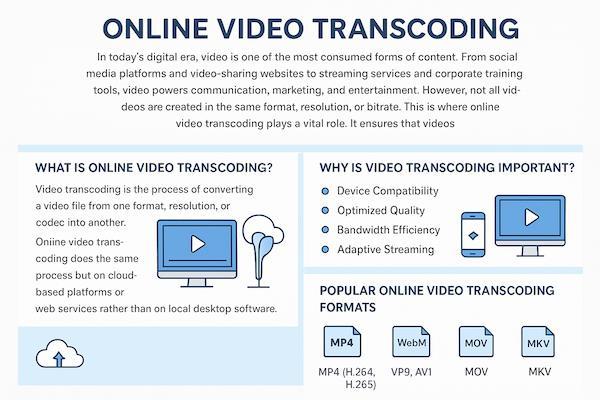In today’s digital era, video is one of the most consumed forms of content. From social media platforms and video-sharing websites to streaming services and corporate training tools, video powers communication, marketing, and entertainment. However, not all videos are created in the same format, resolution, or bitrate. This is where online video transcoding plays a vital role. It ensures that videos are accessible, compatible, and optimized for every device and platform.
What is Online Video Transcoding?
Video transcoding is the process of converting a video file from one format, resolution, or codec into another. Online video transcoding does the same process but on cloud-based platforms or web services rather than on local desktop software.
For example, a video recorded on a DSLR camera may be in .MOV format, but if you want to upload it to a streaming platform like YouTube or Netflix, it needs to be converted into MP4 (H.264 or H.265) format to ensure smooth playback. Online transcoding services make this possible without requiring users to install heavy software or invest in powerful hardware.
Why is Video Transcoding Important?
Not all users access video content on the same device or internet connection. A video that plays smoothly on a high-speed desktop connection may buffer endlessly on a mobile phone with limited bandwidth. Online transcoding solves this by creating multiple versions of a video to suit different needs.
Some key reasons why transcoding is important include:
- Device Compatibility: Ensures videos play on all devices—smartphones, tablets, smart TVs, and desktops.
- Optimized Quality: Adjusts resolution and bitrate for smooth playback.
- Bandwidth Efficiency: Converts videos into lower sizes for users with slow internet.
- Adaptive Streaming: Supports technologies like HLS (HTTP Live Streaming) and MPEG-DASH for real-time playback adjustments.
How Online Video Transcoding Works
The process typically involves three main steps:
- Upload Video: The raw video file is uploaded to an online transcoding service.
- Select Output Settings: The user can choose the desired format, resolution, codec, and bitrate.
- Transcoding Process: The platform processes the video in the cloud and provides a downloadable or streamable version.
Many online services also allow batch transcoding, where multiple videos can be converted at the same time, saving creators a lot of effort.
Popular Online Video Transcoding Formats
Online transcoding supports a wide range of formats. Some of the most common include:
- MP4 (H.264, H.265): Universal playback format used by most platforms.
- WebM (VP9, AV1): Popular for web browsers and streaming.
- MOV: Common in Apple devices and editing workflows.
- MKV: Flexible container often used for high-quality video storage.
- FLV: Once popular for Flash-based video streaming, now less common.
Advantages of Online Video Transcoding
Using cloud-based transcoding platforms offers several benefits:
- No Need for Expensive Hardware: Everything is processed on cloud servers.
- Accessibility: Can be used anywhere with an internet connection.
- Scalability: Ideal for businesses handling large volumes of video.
- Integration with Streaming Platforms: Many services directly integrate with video hosting solutions.
Challenges of Online Video Transcoding
While online transcoding is convenient, there are some challenges to consider:
- Privacy Concerns: Uploading sensitive or private videos to third-party platforms may pose security risks.
- Processing Time: Large files may take a long time to upload and convert.
- Internet Dependency: Requires a stable and fast internet connection.
- Cost: Free services have limitations, while premium services may charge based on file size or usage.
Applications of Online Video Transcoding
Online video transcoding is used in many industries, including:
- Streaming Services (Netflix, YouTube, Twitch): For adaptive bitrate streaming.
- E-Learning Platforms: Optimizing lecture recordings for students with different bandwidths.
- Corporate Communications: Ensuring video training materials play across all employee devices.
- Social Media Platforms: Transcoding user-uploaded content for better playback.
- Media Production: For delivering content in multiple formats to different broadcasters.
The Future of Online Video Transcoding
With the rise of AI-driven optimization and next-generation codecs like AV1, the future of video transcoding looks promising. Cloud platforms will continue to evolve, offering faster, more secure, and more cost-effective transcoding solutions. Additionally, edge computing and real-time AI transcoding will enable even smoother experiences for live streaming and interactive video applications.
Conclusion
Online video transcoding is the backbone of modern video distribution. It ensures that videos are not just created but also accessible, scalable, and optimized for every device and internet condition. As video continues to dominate the digital world, the role of transcoding will only become more essential. Whether you are a content creator, business owner, or streaming platform, embracing online transcoding is key to reaching wider audiences without compromising on quality.



